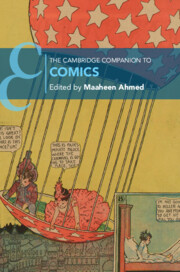Book contents
- The Cambridge Companion to Comics
- The Cambridge Companion to Comics
- Copyright page
- Contents
- Figures
- Contributors
- Acknowledgments
- Chronology
- Introduction
- Part I Forms
- Part II Readings
- Part III Uses
- Chapter 13 Comics and Their Archives
- Chapter 14 Readers and Fans
- Chapter 15 Comics in the Museum
- Chapter 16 Comics in Libraries
- Chapter 17 “Educationally Occupied”
- Further Reading
- Index
- Cambridge Companions To …
- References
Chapter 16 - Comics in Libraries
from Part III - Uses
Published online by Cambridge University Press: 17 August 2023
- The Cambridge Companion to Comics
- The Cambridge Companion to Comics
- Copyright page
- Contents
- Figures
- Contributors
- Acknowledgments
- Chronology
- Introduction
- Part I Forms
- Part II Readings
- Part III Uses
- Chapter 13 Comics and Their Archives
- Chapter 14 Readers and Fans
- Chapter 15 Comics in the Museum
- Chapter 16 Comics in Libraries
- Chapter 17 “Educationally Occupied”
- Further Reading
- Index
- Cambridge Companions To …
- References
Summary
Until the 1990s, comic books rarely served anything other than a deeply conflicted, even paradoxical role in American public libraries. With rare exceptions, comic books as actual objects did not exist in libraries, but as emblems, comics appeared repeatedly in the professional and public conversations in which librarians participated. To librarians of the mid-century, comic books served the important role of symbolizing everything that libraries opposed, thereby reinforcing librarians’ sense of their own professional identity. Comics represented first and foremost an ephemeral and inferior product of junk culture that took up the finite amount of time and attention that children were imagined to have to spend on reading, meaning that librarians saw them as something that interfered with real reading of legitimate books. Further, comics represented a threat to the authority of children’s librarians, who had crafted a professional identity based on their knowledge of good literature for children. Because comics were imagined to interfere with children’s interest in such literature and because children could access comics without librarian expertise, librarians saw comics as a significant threat. However, comics themselves presented a much more complicated vision of literature, literacy, and even public libraries.
Keywords
- Type
- Chapter
- Information
- The Cambridge Companion to Comics , pp. 327 - 345Publisher: Cambridge University PressPrint publication year: 2023

